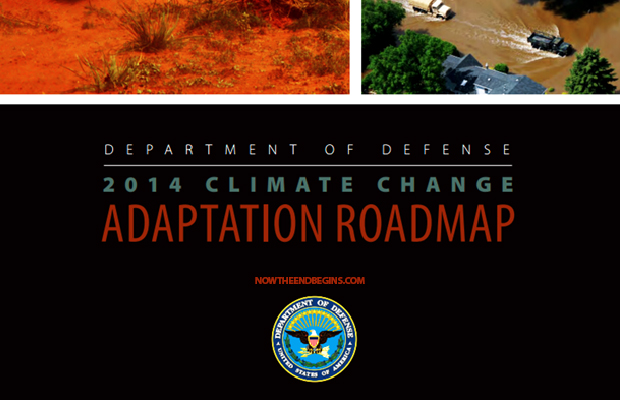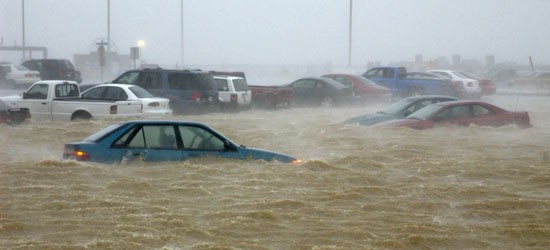October 21, 2014 – Don’t know the answer. Well it’s the people who occupy the biggest building in the world, the Pentagon in Washington, D.C. Called a “threat multiplier,” the American Department of Defense (DoD) points to “rising global temperatures, changing precipitation patterns, climbing sea levels, and more extreme weather events” as intensifying “the challenges of global instability, hunger, poverty, and conflict.” So the Pentagon is planning for the challenges by first identifying the impacts climate change will have on its role and operations “using the best available science.” It begins by looking at existing site vulnerability such as Hampton Roads and Norfolk in Virginia where recurrent flooding (see image below) is already increasing in frequency, and in anticipation of rising sea levels equal to 0.45 meters (1.5 feet) within the next 50 years, will lead to relocation or a significant investment on site to hold back the ocean.
Chuck Hagel, the Obama administration’s Secretary of Defense, in presenting the roadmap stated “politics or ideology must not get in the way of sound planning.” The DoD, therefore, has adopted a three-part strategy:
- Identify and assess the effects of climate change on the Department.
- Integrate climate change considerations and manage associated risks to the Department.
- Collaborate internally and externally to deal with climate change challenges.
All departments of the DoD are to review their capability and capacity to operate at home and abroad in light of global climate change.
All are to determine operational readiness and train and test critical functions to ensure when faced with climate change impacts they can continue to operate at a high level.
And all infrastructure necessary for DoD operations is to be looked at in light of climate change impacts.
It is interesting to read the roadmap while assessing comments made by those politicians in the United States who are currently running for elected office in the mid-term 2014 vote. These include many in the Republican Party leadership including Wisconsin Congressional Representative Paul Ryan, the former Vice Presidential candidate in 2012. For the man, seen below in his official Congressional portrait, who has stated he believes in the importance of defense readiness, to remark “I am not a scientist” and then go on to declare “we’ve had climate change forever,” an absolute, followed by “the benefits do not outweigh the costs,” in reference to adaptation strategies, smacks of duplicity or willful ignorance.
Ryan, the non-scientist, has declared climate change is situation normal and therefore, there is no reason to do anything about it. And besides if we tried to do something it would cost too much. But what about the implications to the U.S. Navy installations in places like Norfolk and Hampton Roads? Surely as a Republican Congressman, Ryan can see the benefit of spending money to deal with the climate change forever impact on the U.S. Navy’s largest defense facility on the Eastern seaboard.
The climate change contrarian, Ryan, is joined by many similar-minds in the U.S. Congress. Republican Senator and Minority Leader Mitch McConnell is a leader among the equally ignorant, a passel of Congressional Republicans who are apparently following a party line that claims to not “know the science behind climate change.”
And frightfully the Republicans aren’t alone in being willfully blind, deaf and dumb. Democrats in both the House and Senate are also playing the denial game. And some from both parties sit on those committees with oversight for the Environmental Protection Agency (EPA) and DoD.
Nevertheless DoD is forging ahead and in particular looking at impacts to infrastructure. The roadmap document states, “Climate change will have serious implications for the Department’s ability to maintain both its built and natural infrastructure, and to ensure military readiness in the future.” Some anticipated climate change effects include:
- Increasing inundation, erosion, and flooding of infrastructure.
- Changing energy requirements for buildings and installations.
- Disruption of easily accessible freshwater supplies at installations.
- Damage to polar infrastructure from thawing of permafrost and sea ice melt.
- Extreme heat damage to runways, roads and other infrastructure.
- Changing disease distribution vectors impacting the health of defense personnel.
One wonders how the U.S. military, traditionally very conservative in outlook, can clearly see the impacts of climate change and the need for an adaptation process and strategy while at the same time, those who seek to govern, or are currently in a major branch of the federal government, deny the existence of the challenge at all. What cause do these latter serve? Perhaps the position of the military is because they are contributing to the science of climate change through DoD earth-space environmental data. DoD, through its Air Force Weather Agency, and the Navy’s Fleet Numerical Meteorological and Oceanographic Center, provide up to 500,000 daily global weather observations from satellites and sensors deployed around the planet. They’ve been gathering such information for a very long time and the data is clearly behind the need for an adaptation strategy. DoD sees those 97 to 98% of the climate scientists as being right whereas Congressman Ryan, “I’m not a scientist,” and his ilk, as getting it all wrong.























[…] FUTURE OBSERVATORY: Who Has a Climate Change Adaptation Roadmap? Guess! https://www.21stcentech.com/climate-change-adaptation-roadmap-guess/ […]